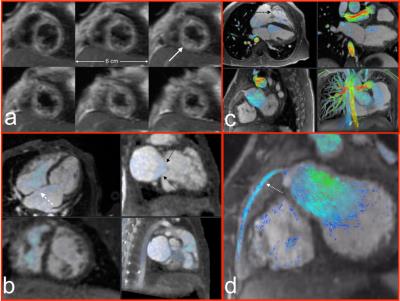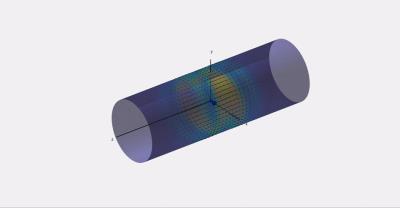Poster: RF Arrays & Systems
Electronic Power Pitch Poster
Engineering
Wednesday, 26 April 2017
| Exhibition Hall |
14:45 - 15:45 |
| |
|
Plasma # |
|
0755.
 |
1 |
Development and Clinical Implementation of Very Light Weight and Highly Flexible AIR Technology Arrays 
Shreyas Vasanawala, Robert Stormont, Scott Lindsay, Thomas Grafendorfer, Joseph Cheng, John Pauly, Michael Lustig, Greig Scott, Jorge Guzman, Victor Taracila, Daniel Chirayath, Fraser Robb
Pediatric body MRI faces challenges of widely varying patient sizes, heterogenous imaging indications, and limited patient cooperation. These difficulties are compounded by receiver array coils that are often mismatched to patients’ size. In this work, we develop a novel light-weight flexible coil array that can be placed on a patient, and combined with a high-density posterior array and determine feasibility of clinical use in a pediatric setting. The resulting coil is well received in the clinic and yields good image quality.
|
|
0756.
 |
2 |
The Optimality Principle for MR signal excitation and reception: new physical insights into ideal RF coil design 
Daniel Sodickson, Riccardo Lattanzi, Manushka Vaidya, Gang Chen, Dmitry Novikov, Christopher Collins, Graham Wiggins
Despite decades of collective experience, RF coil optimization has remained a largely empirical process, with clear insight into what might constitute truly task-optimal, as opposed to merely “good,” coil performance being difficult to come by. We introduce a new principle, the Optimality Principle, which allows one to predict the form of signal-optimizing current patterns on any arbitrary surface, using a simple conceptual framework. After a brief derivation of the principle, we illustrate its use in generating ideal current patterns for various experimental conditions, and in understanding the emergence of electric dipoles as strong performers at high frequency.
|
 |
0757.
 |
3 |
Self-Decoupled RF Coils - permission withheld
Xinqiang Yan, John Gore, William Grissom
RF arrays with large numbers of independent elements are desirable for parallel imaging and transmission. However, electromagnetic (EM) coupling between elements becomes significant as the number of coils increases and can severely impact coil performance. Several methods such as overlapping elements, L/C networks and auxiliary resonators have been proposed to reduce coupling, and are effective in decoupling adjacent elements, but are usually less effective for non-adjacent elements, and are not directly applicable to recently-proposed mixed arrays such as combinations of dipoles/monopoles and loop arrays. To address these problems, we propose a simple, geometry-independent self-decoupled RF coil design in which the two induced current modes in a loop coil can be adjusted to cancel each other. The method is validated in EM simulations, bench tests and MR experiments.
|
 |
0758.
 |
4 |
Optically Controlled Four-Channel Transceiver for 7T imaging with RF Monitoring Feedback 
Natalia Gudino, Jacco de Zwart, Peter van Gelderen, Jeff Duyn
In multi-channel RF transmission, monitoring and accurate control of amplitude and phase of the transmit signal is necessary to ensure safety. To this end, we present a four-channel transceiver array for 7T imaging built from optically-controlled on-coil amplifiers with optical real-time RF signal monitoring. Based on this monitoring signal an amplitude and phase control can be implemented for flexible, accurate and rapid control of B1 and SAR.
|
|
0759.
 |
5 |
Double-Row 16-element Tight-Fit Transceiver Phased Array with High Transmit Performance for Whole Human Brain Imaging at 9.4T. 
Nikolai Avdievich, Ioannis Giapitzakis, Anke Henning
At ultra-high fields (UHF, >7T) a simple increase of the length of a single-row human head transmit (Tx) phased array cannot provide an adequate longitudinal coverage for the whole brain imaging. Multi-row (>2) arrays together with RF shimming have to be used instead. In this work, we constructed a 9.4T (400 MHz) 16-loop double-row transceiver array based on the analytical modeling. We demonstrated that simply by overlapping a very good decoupling can be obtained without additional decoupling strategies. This provides a recipe of a simple, robust, and very Tx-efficient design for parallel transmission and whole brain imaging at UHFs.
|
|
0760.
 |
6 |
Compact iPRES coil assembly for Magnetic Resonance Fingerprinting 
Michael Twieg, Bhairav Mehta, Simone Coppo, Haoqin Zhu, Labros Petropoulos, Hiroyuki Fujita, Mark Griswold
Magnetic Resonance Fingerprinting (MRF) makes use of spatially and temporally incoherent encoding schemes to produce orthogonal signals from different tissues. Here we present a coil optimized for MRF that integrates parallel receive, excitation, and shimming (iPRES) to provide an ideal method of modulating all three available magnetic fields (B1-, B1+, and ΔB0). In order to be useful in quantitative imaging, an iPRES array must convey these fields accurately, and cost effectively. Here we demonstrate an iPRES coil element with all three field amplifiers located on-coil, providing improved sensitivity and efficiency relative to remote amplifiers.
|
 |
0761.
 |
7 |
Wireless coil based on meta-technologies for MRI implementations 
Alena Shchelokova, Alexey Slobozhanyuk, Irina Melchakova, Andrew Webb, Yuri Kivshar, Pavel Belov
We demonstrate experimentally how to improve the performance of MRI by employing wireless coil based on a hybrid tunable metasurface. We fabricate metasurface formed by an array of nonmagnetic metallic wires with high permittivity dielectric loads and investigate it in 1.5 T MRI machine. The metasurface enhances the SNR value in more than 7 times in the region of interest in comparison with the birdcage coil and 2 times versus the dedicated flat local coil.
|
 |
0762.
 |
8 |
Development and performance evaluation of the second prototype of a RF-coil integrated PET insert for existing 3T MRI systems - permission withheld
Md Shahadat Hossain Akram, Fumihiko Nishikido, Takayuki Obata, Mikio Suga, Eiji Yoshida, Hedeaki Tashima, Keiji Shimizu, Masanori Fujiwara, Akram Mohammadi, Taiga Yamaya
We developed an RF-coil integrated DOI-PET insert for the 3T MRI system for human brain imaging. In this study we have given details of the second prototype system developed recently and evaluated performance for MRI-only, PET-only and simultaneous PET/MRI conditions. This system included 24 carbon fiber shielded PET modules which are positioned in between the coil-elements of a birdcage head-coil. In total 48 4-layer DOI detectors are included that gives 60 mm axial-FOV for PET imaging. Under all performance study the system worked quite well showing promise for near-future human brain study.
|
|
0763.
 |
9 |
Characterization of a new ultra-flexible, low profile RF receive coil technology. 
Philip Rossman, Robert Stormont, Scott Lindsay, Fraser Robb, Dennis Savitskij, David Stanley, John Huston, Timothy Kaufmann, Kiaran McGee
A new highly flexible RF coil design is described. Individual coil elements are constructed by means of a proprietary process that yields low reactance and low loss conductors while being lightweight, flexible, and durable. Phantom data indicate that for similar coil geometries, the coils provide equivalent SNR profiles but do not suffer from design limitations due to minimum coil overlap requirements of conventional copper coil elements. In vivo data demonstrate that these coils can be fabricated onto highly flexible and thin support materials that closely comply with anatomic contours in challenging imaging sites such as the c-spine.
|
|
0764.
 |
10 |
Resonance frequency detection of a stretchable RF receiver coil for MRI 
Andreas Mehmann, Christian Vogt, Benjamin Sporrer, Matija Varga, Qiuting Huang, Gerhard Troester
Wearable RF receiver coils change their resonance frequency when stretched or bent. We propose a system that detects this change in resonance frequency. The system is integrated on a wearable MRI receiver of 20 x 30mm˛. The change in resonance frequency can be detected in-field. The detection works by sweeping an excitation current through a frequency range and measuring the frequency response. The frequency response is transmitted via a glass fibre to an out-field signal processing unit. Measurements were conducted using a stretchable liquid metal coil on neoprene.
|
| |
0765.
 |
11 |
Mary had a little Lamb: Scanner-recorded speech during MRI without gradient-induced sound
Jan Pedersen, Christian Hanson, Rong Xue, Lars Hanson
During MRI, fast switching of imaging gradients generate loud noise of high intensity due to vibration of the gradient coils. The in-bore intercom used for patient communication is therefore typically turned off during scanning. This has implications for safety and image quality since patient speech and yells are not heard by the scanner operator. Using standard sequences, we demonstrate that sound can be recorded by MRI scanners and extracted from the scanners raw data, thereby enabling communication with patients for safety or experimental reasons.
|
|
0766.
 |
12 |
Dielectric resonator antenna receive array at 7 Tesla using detunable ceramic resonators 
Thomas Ruytenberg, Andrew Webb
A receive-only array of dielectric resonator antennas has been developed. A method for detuning the ceramic resonators is studied using simulations and measurements, after which a four-channel dielectric resonator antenna array is used for in vivo image acquisition of the ankle. Using this receive-only array allows for higher SNR and parallel imaging using SENSE.
|
|
0767.
 |
13 |
Top-Hat Dipole RF Coil with Large Field of View for 7 T Brain MR Imaging 
Chang-Hyun Oh, Chulhyun Lee, Suchit Kumar, Jun-Sik Yoon, Ha-Kyu Jeong, Jeong-Hee Kim, Young-Seung Jo, Jong-Min kim, Christian Bruns, Tim Herrmann, Johannes Bernarding, Zang-Hee Cho
In ultra-high-field brain MR imaging, the coverage for imaging with the optimized protocol is constrained not only by scan time, but also by the coil structure. Since presently available surface loop RF coils have limited field of view, it is very difficult to achieve the coverage from the top of the head to the end of the cervical vertebrae. Prior solution to this problem was to increase the number of elements. However, it increases the complexity of coil array design thus causing difficulties in construction of the coils. In this paper, an 8-channel top-hat dipole receive RF coil is proposed for the brain imaging at 7 Tesla MRI. By enabling the coil tuning with novel tuning methods for shorter RF coil lengths but still with reasonable uniformity and SNR for more imaging field of view compared with multi-element loop coils.
|
 |
0768.
 |
14 |
Bioreactor for in vitro optical fluorescence and magnetic resonance spectroscopy 
Benjamin Cox, Joseph Szulczewski, Kai Ludwig, Erin Adamson, Robert Swader, Sarah Erickson-Bhatt, Patricia Keely, Kevin Eliceiri, Sean Fain
The design and implementation of a novel bioreactor capable of facilitating both magnetic resonance spectroscopy (MRS) and optical fluorescence microscopy for complementary metabolic information is described. Fluorescence lifetime imaging (FLIM) of nicotinamide adenine dinucleotide (NADH) and hyperpolarized [1-13C] pyruvic acid (PA) MRS of human breast cancer cells in a 3D collagen matrix is demonstrated. The system provides a novel test-bed for simulating cell-matrix and cell-cell interactions in a 3D microenvironment for investigating multi-scale cellular metabolism in vitro.
|
 |
0769.
 |
15 |
Multimodal Imaging: MR-Compatible, Gradient Artifact free, Wireless recording system integrated with MR-scanner for Simultaneous EEG and fMRI acquisition 
Ranajay Mandal, Nishant Babaria, Jiayue Cao, Zhongming Liu
The field of multimodal imaging has largely been propelled by two of the most widely used neuroimaging tools, fMRI and EEG, as the complementary nature of the two signals provides a unique avenue to evaluate the brain dynamics and its underlying neural circuitry. However, methodological challenges associated with simultaneous acquisition of EEG and fMRI impedes the method from achieving the full potential. To address these challenges, we present an MR-compatible, active recording system that utilizes surplus MR-hardware and inherent electromagnetic field to synchronize and wirelessly record gradient artifact free multichannel EEG signals and encode these Non-MR signals within the extended FOV of the MR image.
|
|
0770.
 |
|
SUstainable RF-coil for Breast or Other Applications in Research and Development (SURFBOARD) 
Christopher Wiggins, Benedikt Poser
Industrial manufacturers are increasingly subject to environmental regulations regarding waste products. This has included MRI manufacturers who generally need to adhere to RoHS standards. Additionally, concerns about pollution and global warming have resulted in a trend towards the use of recycled and other materials that are considered sustainable. With this background, we conducted a feasibility study as to whether this could be applied in the academic research environment, particularly relating to the development of RF coils for breast applications.
|
|
 Power Pitches Video
Power Pitches Video
















